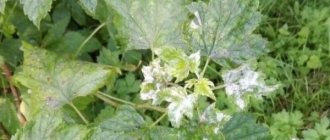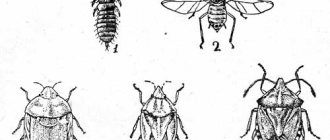What does it look like
It is quite difficult to see it with the naked eye.
Biologists classify it as arachnid, a type of arthropod. This is due to the structure of the body - it has several legs (in adults - 8, in larvae - 6), which makes it vaguely similar to a spider. Color varies from pale, greenish-yellow, translucent. Internal organs are visible, they look just like dark spots on the back. But there are other types that are more noticeable in color, such as bright red.
Adult females acquire an orange and reddish hue closer to winter, which makes them easier to detect on the plant. They have small “claws” on their legs that help them attach to leaves.
Ticks spin a thin web in which both adults and larvae live. The life cycle of each tick is up to 50 days.
Description
Spider mites reproduce very quickly and instantly move from one plant to another. Pests feed on the contents of plant cells. The presence of mites can be detected by the appearance of small white dots on the leaves of the plant on the underside of the plate and by the thinnest cobwebs. As a result of the activity of spider mites, some of the plant cells are destroyed, and the intensity of photosynthesis decreases.
With severe damage, the leaves turn white from multiple damages, the plant is enveloped in cobwebs, and a mass of mites accumulates on the tips of the leaves and shoots.
In addition, the mite can infect the plant with incurable viral infections and gray rot spores.
- Rodents: how to get rid of them and why they are dangerous
At home, in the garden and garden, plants are damaged by several types of spider mites:
- common (lat. Tetranychus urticae): the length of female common spider mites can be from 0.4 to 0.6 mm, males are usually shorter - from 0.3 to 0.45 mm. At the larval stage of development, mites are transparent, painted in different colors: from pale green to greenish-brown. Large dark spots are clearly visible on the sides - the blind sacs of the midgut. Tick larvae have 6 legs, and adults have 8 translucent legs with prehensile claws. Spider mites live everywhere except Antarctica. The life cycle of the common tick consists of several stages: egg, larva, nymph and adult, colored red-brown and orange (females), as well as greenish or yellowish (males). The common spider mite is a polyphagous, that is, a polyphagous arthropod;
- red (lat. Tetranychus cinnabarinus). This pest damages agricultural and ornamental plants. In warm regions it lives in open ground, and in northern regions it lives only indoors;
- Atlantic (lat. Tetranychus atlanticus) – a ubiquitous species of mite that damages cucumbers;
- Turkestan (lat. Tetranychus turkestani) is a polyphagous plant that feeds on both garden plants (tomatoes, peppers, cucumbers) and ornamental plants.
Common pests from this family also include red-legged and Savzdarga ticks. However, despite such a variety of pest species, measures to combat spider mites are almost the same.
Description of the spider mite
Biologists note the very small size of the insect, 0.2-1 mm, so that it is almost impossible to see it without a magnifying glass. The color of the tick is light green, red or yellow, depending on the type of this arachnid creature. Females are capable of laying 7 eggs per day, placing them on the fleecy side of the leaves. In winter, the female hides the clutch in the bark of a tree or in fallen leaves.
The most common type of tick in Russia: the common one, which eats many plants, from garden to indoor ones. Another name for this pest is berry, strawberry or strawberry pest.
The spider mite got its name because it weaves webs on green spaces.
Interesting! There is one ornamental plant - castor bean, the seeds of which look like small ticks. These seeds are very poisonous and dangerous to humans.
Plane beetles, or false spider mites, are often confused with spider mites. Their sizes are exactly the same, but they do not weave webs. They, unlike their relatives, love high humidity.
Why is it dangerous for plants?
Since this insect sucks the juice from the leaves, this leads to the gradual death of some tissue. Numerous “dead zones” form a drying area, resulting in leaves falling off. And without foliage, the plant cannot feed and develop, so it dies.
In addition to this main reason why ticks are dangerous, there are several more:
- it carries viral and fungal diseases;
- spreads gray mold spores;
- makes the plant vulnerable to disease.
Before the insects have time to multiply exponentially, it is immediately necessary to apply various methods of combating larvae, eggs and adults of spider mites.
How to recognize a spider mite
The first signs of mite infestation of plants:
- The leaves begin to turn yellow from the bottom. Affected areas lose chlorophyll, become discolored and dry out.
- Since the leaves do not receive the required amount of nutrients, they curl and fall off.
- The places where the spider mite colony has settled are covered with a thin web.
- If you do not start fighting these pests, the plant gradually weakens and may die.
Spider mite is a pest of indoor plants. How to fight at home? Watch this video on YouTube
Signs of spider mites on indoor plants
Due to their tiny size, spider mites are almost impossible to see without glasses or a magnifying glass. Insects hide well on the back of leaf blades or just earthen lumps. Adults exhibit mimicry - they blend in with greenery, having similar color shades. Wintering females are easier to recognize; they have a reddish tint.
The main signs of ticks are:
- Light single punctures on the leaf blades, which can be seen in the light. At first there are few of them, but the number gradually increases. Over time, the lesions grow and merge into large brown, pronounced spots.
- Greenery loses its natural color: it becomes yellow, gray, and acquires bronze or red shades.
- The leaves change: they curl, deformations occur. The same applies to buds.
- Growth and development stops. Photosynthesis is disrupted, cells cease to function properly and absorb nutrients.
- In the later stages, a network of thin, barely visible to the eye, cobwebs. Sometimes they can only be seen when there is a large concentration of pests or on a completely dried out plant.
First of all, you need to look for the skins that adults shed after molting. They are white grains, similar to dandruff, located on the inside of the leaf. At the initial stages, the web appears between the veins, and can only be seen with a magnifying glass.
With severe pest damage, the plant looks sick, lethargic, loses green mass and may die.
Symptoms of plant damage
Spider mites on plants appear as small, light-colored or brownish moving crumbs. But they can only be noticed after the colony becomes large enough. It is possible to identify a parasite infection earlier by some characteristic signs:
- light punctures appear on the leaves, as if made by a needle, which darken over time, merge, turning into brown spots;
- the leaves become faded and begin to turn yellow;
- Over time, the leaves begin to curl and dry out, the buds become deformed and wither;
- a cobweb appears on the back of the leaves, which gradually entwines the entire plant;
- with extensive infestation, clutches of spider mite eggs can be seen on the back of the leaves.
Signs of defeat
Without proper treatment, the development and growth of the plant slows down, it looks sick, begins to lose leaves and may die.
Reasons for the appearance of spider mites on indoor plants
Flower growers who grow a large number of different flora on windows or balconies sooner or later encounter tick attacks. Knowing the prerequisites for the occurrence of parasites in the house, you can prevent their appearance and secondary infection.
There may be several reasons for the abundance of ticks:
- A new plant from the store or borrowed from friends. It is better to keep new arrivals separately in so-called quarantine for 1-2 weeks.
- Open window. Residents of the lower floors are most at risk, as a colony of pests can reach them from the nearest tree. Flowers located on unglazed loggias are at risk. A person can carry ticks on clothing or the soles of shoes.
- Contaminated substrate purchased from a store. Another option is soil taken from a flower bed for replanting.
- Tanks and pallets that have not been used for a long time.
- Heating season in winter. In cold weather, females hibernate and become inactive until favorable conditions occur. Eggs can be in diapause for up to 5 years.
The gardener needs to inspect home plants daily, because with low humidity and high air temperatures, the mite population increases sharply. The female, despite her short life span, manages to lay 150-200 eggs in 2-3 weeks, the maturation time of which is 1-3 days.
Mr. Summer Resident recommends: prevention of spider mite infestation of indoor plants
To protect flowers, minimize the risk of infection and not waste energy on treatment, it is better to perform the following preventive actions:
- Exercise caution when purchasing new plants or replanting existing ones.
- Conduct regular inspections for the presence of parasites.
- Disinfect the substrate, expanded clay for drainage, purchased in the store, with a solution of potassium permanganate or bake on a baking sheet (baking sleeve) in the oven for 40 minutes at a temperature of +180 °C. Another way is to steam the soil in a sieve with a layer of gauze in a water bath for 20 to 90 minutes. After the procedures, it is important to add yeast or other bacterial fertilizer.
- Treat with special fungicides such as Fitosporin, Alerin, Agat, Baktofit.
- Carry out a 2-3 week quarantine for newly arrived specimens.
- Give the greenery a periodic shower.
- To humidify the air by spraying from a spray bottle, however, it is best to purchase a humidifier.
Spider mites are a dangerous pest that damage a wide variety of indoor plants and cause trouble for gardeners. However, by following simple rules, performing preventive actions and carrying out consistent, systematic treatment, you can reduce the risk of infection to a minimum.
Kinds
To fight a pest, you need to know exactly what it looks like. This mite is an arachnid, its body usually has a length of 0.2 to 1.2 mm. However, some varieties can reach a size of 5 mm. The duration of the life cycle of individuals is from 8 to 40 days. It takes approximately a week for the egg to develop into a viable tick that is ready to reproduce.
Most often, it is difficult to examine the animal itself; its appearance is identified by the appearance and condition of the plant.
There are quite a few varieties, but not all of them affect indoor plants.
Ordinary
This variety can be considered the most dangerous and most common. The main problem is omnivory, with the exception of coniferous trees.
These arachnids attack crops and can also live on indoor plants. Their size is about half a millimeter. Both eggs and adults are yellow-green in color. Crops are eaten at the roots. Several broods appear annually.
Red
These pests have a particular weakness for indoor flowers. For example, roses, lemons, orchids and others suffer from them. These mites are very heat-loving, so they reproduce well at home. Females are brighter than males.
Atlantic
These small green-yellow pests can reach sizes of 0.4 mm. The most comfortable conditions for reproduction are warmth and high humidity. Among indoor plants, preference is given to palm trees and citrus fruits.
False
The false mite is distinguished by the fact that it does not weave a web around the plant. It is very small, approximately 0.2 mm. The color can be red or green. Such pests attack citrus fruits, orchids and palm trees.
Cyclamen
As the name suggests, the pest is an adherent of certain crops. Most often it affects cyclamens. If they are not found, it will settle on geraniums or gloxinias.
The cyclamen spider mite often lives in greenhouses. The most comfortable conditions for its active development are high humidity and warmth. It is very small, capable of reaching a maximum size of 0.2 mm, so it is quite difficult to examine it.
Clusters of pests resemble dust in appearance.
Wide
This mite very rarely lives in garden areas, preferring indoor plants. It is not too difficult to fight, as it usually does not hide its clutches well. May appear mainly on cacti, ficus or citrus fruits.
Cactus flat
Such mites are also known as “flat mites”. It does not weave webs, for this reason it is not conspicuous, and there may be problems with finding it. Prefers to eat citrus fruits.
Clover
Despite the fact that this pest is recognized as a lover of cereals, it can often be found on house plants. It has long legs and moves quite quickly, infecting large areas. In apartments he prefers to live on ficus and pereromia trees.
Types of ticks
Cobwebs on flowers: what to do? To understand how to remove spider mites from indoor flowers, you need to know that they come in several types :
- common spider mite : its extensive populations settle on the lower parts of leaves and on the tops of young shoots; as the colony grows, individual individuals begin to spread throughout the windowsill, infecting more and more new plants; in a short period of time they can infect the entire collection; most often they affect fuchsias, impatiens, ficuses, roses and dracaenas; the first sign of such a lesion is yellow spots on the leaves and small white cobwebs;
- red mite : most often settles on balsam, rose, nightshade, orchid, lemon; actively reproduces at high air temperatures;
- false tick : dangerous because it is very small in size and not at all visible to the naked eye; it does not weave webs, so the defeat is noticed only when the plant begins to die;
- Atlantic mite: mainly affects exotic palm trees and citrus fruits, but can spread to any plant; one of the few mites that actively spread when indoor humidity is high;
- cyclamen mite : spreads to gloxinia, chrysanthemum, cyclamen, pelargonium, balsam, violet; it lives not only on the leaves, but also in the tubers of plants; large colonies look like a layer of dust; unlike most of its counterparts, it loves high air humidity;
- broad mite: likes to settle on anthurium, euonymus, ficus, saintpaulia, oleander, citrus fruits and cacti; he is very fertile; new colonies appear on the leaves of a diseased plant every 3-4 days; they are easy to spot: red clusters of dust and cobwebs are visible; females do not huddle in hard-to-reach places to lay eggs, so it is easy to fight;
- cactus flat mite (bryobia) : affects exotic plants, can be detected by white or yellowish intermittent stripes on the leaves; the female lays large orange eggs, extending chains of them along the veins of the leaf; found on Saintpaulia, Fatsia, can spread to any plant;
- clover mite : it affects ambutylone, ficus, euonymus, peperomia, orchids and various bulbous plants; eats away entire passages, filling them with brown dust.
Houseplants are also attacked by other types of poutine mites: Pacific, strawberry, red (flat) mites.
All ticks are capable of adapting to the most unfavorable conditions , inhibiting vital processes until the onset of good conditions for reproduction. This state is called diapause.
Read more about these and other types of spider mites in our article “Types of spider mites. How to recognize a harmful parasite?
Treatment
How to treat flowers against spider mites at home?
The following folk remedies for fighting spider mites are suitable:
- vodka diluted with water;
- infusion of dandelion ;
- garlic infusion;
- decoction of cyclamen ;
- infusion of calendula .
You can learn how to treat indoor flowers against mites using a cyclamen tuber
Folk remedies cannot always cope, and then you have to resort to stronger drugs :
- "Intavir";
- "Fitoverm"; "Karbofos";
- "Aktellik";
- "Alatar".
You can read in detail how to use spider mite control products.
All products will be effective only with repeated processing . Neighboring plants, frames and window sills also need to be treated.
How can you remove insects at home?
After discovering spider mites on home flowers, it is necessary to urgently isolate the affected plants and begin treating them. Preventive measures should be applied to healthy plants. You can fight the pest using several methods: from special chemicals to the use of improvised means.
Chemical methods
Specialized preparations are used in cases of significant pest damage to flowers. The following are popular:
- Sunmite;
- Flumite;
- Apollo;
- Oberon;
- Floromite.
Important! When processing with chemicals, it is necessary to follow the safety measures specified by the manufacturer.
Biological drugs
Biological products are not as toxic as chemicals. But pets may be harmed by them, so the flowers being treated should not be within their reach.
The following biological preparations are used to control the pest:
- Vertimek;
- Aktofit;
- Agravertine;
- Akarin.
Attention! After treating flowers with biological products, mite eggs survive. Therefore, after a while, the processing procedure is repeated.
How to fight with folk remedies?
To combat ticks, improvised means are suitable. The following infusions and decoctions have proven themselves well:
- Onion infusion. Finely chop a medium-sized onion, then pour 1 liter of boiling water and leave for 4 hours. After time, the infusion is filtered and applied to the infected plant using a spray bottle.
- Infusion of celandine. 2 tablespoons of green parts of the plant are poured with boiling water and left for 4 hours. You need to treat the flower with the prepared infusion.
- Yarrow decoction. 100 grams of green mass of yarrow should be poured into 1 liter of boiling water and boiled over low heat for 3-4 minutes, then left to brew for 3-4 hours, strain and process the plant.
Treatment
How to cure flowers from spider mites? If a mite is detected, the plant must first be thoroughly washed with laundry or tar soap. Lather each leaf and each axil, whipping the foam with your hands and carefully working all parts of the plant. Leave the flower for several hours (or for a day), covering it with a plastic bag . Then rinse off the soap thoroughly under a warm shower.
If the lesion was minor, then such a procedure will be sufficient, although it must be repeated two or three times within a week. The plant should be sprayed with warm water twice a day and inspected regularly.
Wash the frames and window sill with hot water and any detergent . preventive purposes . Spider mites do not tolerate fresh air and ventilation.
What to do if the defeat has gone far enough? You must first treat with soap, then spray with Intavir, Fitoverma, Karbofos . When treating a window, it is also worth adding Karbofos to the water.
Sometimes a fairly simple method helps : place an open container with finely chopped garlic or turpentine , and tightly close the plant along with the container for 2-3 days. The edges of the pot should be lubricated with tar .
Fighting spider mites
The peculiarity of this pest lies, unfortunately, in its survivability. It reproduces quickly and lays a huge number of eggs in a short period. Because of this, unfortunately, it will not be possible to get rid of spider mites in one or two procedures. It is necessary to apply comprehensive measures to destroy both adults, larvae, and laid eggs.
Spider mites at different stages of their life cycle die from different conditions and drugs
Chemicals
Chemical pest control products are most effective, but can be toxic. When using them, it is important to strictly follow safety precautions:
- isolate treated plants from animals and children;
- use medications wearing a protective mask and gloves;
- Carry out thorough ventilation or use the product outdoors.
Please note that ticks are not insects. Spider mites are arachnids, so insecticides (chemicals used to kill insect pests) will not work on them. It is necessary to choose from acaricides:
- "Aktellik" is an insecto-acaricide. This drug is effective against both insects and ticks. Actellik is extremely toxic, so its use indoors is not recommended. If you need to apply it to a houseplant, it is better to take the pot outside or to a well-ventilated balcony while it is being treated. “Actellik” is a very powerful and effective remedy, so it is excellent for mass plant infestations. Unfortunately, it does not kill eggs, so additional treatment with another acaricide is necessary after it. Unlike other means, it can cope not only with the most common ticks (red and common), but also with more exotic species that are rarely found in Russia (date, Atlantic, hawthorn). Actellik is a highly effective but very toxic drug
- "Fitoverm" is an acaricidal agent. It is less toxic than Actellik, so its use is also permissible in enclosed spaces. However, it still poses quite a risk for children and animals, so treated plants must be placed in a place inaccessible to small household members. This product can be used without protective gloves and a mask, but after finishing work, be sure to thoroughly rinse your face, mouth, and hands. “Fitoverm” also does not destroy spider mite eggs, only adults and larvae. "Fitoverm" is an effective and low-toxic acaricide
- "Neoron" is an effective acaricide that destroys not only adult ticks, but also tick eggs. It is toxic, so you need to remember safety precautions and ventilate the room well after using it. Despite the fact that it quite quickly destroys the pest population, one application of the product is not enough - it is necessary to carry out at least three treatments of the plant. It is best to conduct them at intervals of 3-5 days - this is not enough time for the larvae to hatch from the eggs and produce a new generation. "Neoron" is a powerful acaricide that can remove the entire population from a plant
- "Sunmite" - like "Neoron", is an effective means for destroying both adult ticks and larvae with eggs. This drug can only be used once every six months, otherwise the pests may develop immunity. “Sunmite” is used by dissolving at the rate of 1 g of acaricide per 1 liter of water. The plant is carefully sprayed, it is especially important to treat the underside of the leaf - the drug is effective only in direct contact with the larva or adult. "Sunmite" is an acaricide with an ovicidal effect
Biological method
This method was developed by Candidate of Biological Sciences G. A. Beglyarov. Its essence is simple - feed the spider mite to a predator that feeds on them in the natural environment (acariphage). Today, gardening stores offer sachets (small bags) containing natural enemies of the mite - phytoseiulus or amblyseius. The method of control in this case is as follows: the bag is hung from one of the branches of the affected plant and opened. Predators immediately go looking for food. In one day, each of the acarifages eats several adult ticks and several dozen eggs. Within a week, the colony of spider mites is emptied, and the predator itself dies a few days later from starvation.
Phytoseiulus is an acarifage that feeds on spider mites
This method is recognized by scientists and gardeners as extremely effective, but it is not suitable for use on plants with heavily pubescent leaves (for example, violets).
Folk remedies
If the plant has just been attacked by pests, and their population is not yet large enough, you can use gentle folk remedies:
- Medical alcohol. A cotton pad or small sponge should be moistened with an alcohol solution (1:10) and thoroughly wipe all the leaves of the plant. Unfortunately, this method does not destroy tick eggs, but it works well against adult ticks. If the spider mite has not yet had time to leave its future offspring on the leaves of the plant, then such treatment will be enough to get rid of the pest. Look at the underside of the leaf - if you do not find small whitish fixed dots, then the pest has not yet laid eggs. Please note that this method is not suitable for plants with thin and sensitive leaves (rose, fuchsia, petunia), but is well tolerated by denser ones (ficus, dieffenbachia, phalaenopsis). Rubbing alcohol is a universal remedy that will help not only disinfect wounds, but also get rid of pests of indoor plants.
- Tobacco smoke. This method is certainly not the safest for humans, but if you or anyone in your household smokes, you can use this bad habit to eliminate spider mites. The smoker must release smoke onto the plant. Tobacco smoke is extremely harmful to adult spider mites, but it will not get rid of eggs and larvae. Tobacco smoke contains many toxins and combustion products that are harmful to spider mites
- Laundry soap. This method is ideal for plants with large leaves: violets, dieffenbachias, orchids, and some types of ficus. Laundry soap must be whipped into foam and lubricated with it on the leaves of the affected plant. This product does not kill the tick directly, but creates a dense film through which the pest cannot breathe and feed. After treatment, the plant is left with foam on the leaves for 3–5 hours, then the product is washed off with a warm shower with low pressure. Without allowing the plant to dry out, you need to cover it with a plastic bag or any other “cap” that will prevent the moisture from quickly evaporating. The combination of a foam film and high humidity is detrimental to an adult spider mite, but eggs can survive this impact - additional treatment with an acaricide chemical will be required. Laundry soap is one of the most affordable ways to combat spider mites
- Garlic. One large head of garlic must be finely chopped and poured with three liters of water. The mixture is infused for five days, after which it is filtered and sprayed on the leaves of the affected plant. This method can show its effectiveness only at the early stage of the lesion, when the spider mite colony is still very small. Garlic is very useful not only for humans, but also for plants affected by spider mites
Spread of the pest to other plants
Spider mites, unfortunately, very quickly spread to neighboring plants, since they not only have the ability to reproduce quickly, but also the ability to overcome relatively large distances (for a tiny pest). To prevent massive tick infestation of your green pets, you should take the following precautions:
- the plant on which you found a tick must be urgently isolated from other potted plants;
- all plants that were in the same room with the affected one must be checked for signs: cobwebs, eggs, mites themselves;
- if several plants are affected, they also need to be kept isolated from each other until complete recovery.
How to deal with the pest?
Prevention measures and control methods depend on the location of the plants. So, in open ground, treatment is carried out with systemic preparations and ordinary work.
In the garden
The first action against pests in the garden will be regular watering with a hose. A jet directed at the underside of the leaves will wash them off your beloved pets.
It will also help to pick off the affected leaves from the plant and plant calendula nearby. The aroma of this flower will repel ticks.
After harvesting and before planting, it is necessary to dig up the soil. This will help get rid of overwintering female spider mites.
On flowers
Mites must be exterminated as soon as they become noticeable on flowers; acaricides are used for this. One of the effective remedies is Neoron; you can also use Actellik, Vermitex or Vertimek.
But at the initial stage, if only 1-2 plants are affected, you can use ordinary laundry or green soap, use ammonia or ammonia. To do this, prepare a solution - 1 tbsp. A spoonful of ammonia is diluted with 10 liters of water and the leaves are wiped on both sides.
A decoction of cyclamen tubers is also effective against these pests. To prepare the product, you need to cook a couple of pieces for half an hour over low heat. Then let it sit for a day and spray the flowers with a spray bottle, trying to get on the underside, fleecy side of the leaves. The decoction is used once a week; twice the treatment will be sufficient.
In the garden
If a tick appears on bushes or trees, use chemicals: Akarin, Fitoverm, Actellik, Sunmite, Envidor.
Read more about how to treat grapes against spider mites in this article.
On seedlings
To combat mites on seedlings, folk and biological methods are used; predatory phytosailus is added to the spider mite.
The following recipe is also used: take 0.5 kg of black henbane leaves and pour in 5 liters of water, leave for a day and spray the seedlings with this product. Before use, gardeners advise adding 30 mg of liquid soap for adhesion.
Advice! Spraying must be carried out late in the evening, when the sun has already set, otherwise the plants will get burned.
In greenhouses
You can get rid of mites on eggplants, greenhouse tomatoes, and watermelons if you increase the humidity level to 80%, and also:
- Remove all affected leaves and burn them.
- Place turpentine next to the seedlings and cover the soil with film. The tick will suffocate and die. A paste of onion and garlic helps in the same way.
- Feed the plant with phosphorus fertilizers.
- Use insecticides: Neoron, Actofit, biological products: Biotlin, Fitoverm.
On indoor plants
The mite is especially dangerous for indoor flowers: adenium, aloe, money tree and other succulents. A regular soap solution and treatment of the windowsill, window frames and all plants will help get rid of the mite. In total you need to do the procedure 5 times.
Spider mites may have moved onto the curtains, so they need to be washed. The same should be done if you plan to treat the plants with chemicals.
For processing, it is better to use a sponge and soap each leaf and twigs. Soap foam also needs to be applied to the top layer of soil, then this layer will need to be removed and supplemented with a new one.
Important! For urban conditions, the use of insecticides with hazard class 4 is contraindicated. They emit very toxic fumes that affect your health.
Hydrogen peroxide will also help if you wipe the leaves of your favorite flowers with a solution (2 tablespoons of 3% product diluted in 1 liter of water).
Ticks are also afraid of regular dichlorvos. To process it, you need to wrap the flower in cellophane, make a hole in it, pop it, trying not to get it on the plant, and leave it in the cold, for example, on the balcony. After this, repeat the treatment the next day. This method will get rid of the tick in 2 days.
3 effective methods of combating spider mites on indoor plants
An interesting recipe can be found against the parasite using cinnamon, cloves and Provençal spices. Ingredients in a ratio of 1:1:2 teaspoons, pour 1 liter of boiling water, leave with two tbsp. spoons of chopped garlic for 1 hour. Add grated soap and spray the plants.
Folk remedies
It is advisable to fight spider mites with “grandmother’s” means only if the pests have not yet proliferated greatly, otherwise the use of methods is ineffective.
Spraying
Most often, infusions, herbal decoctions and solutions made from products harmful to parasites are used in the fight against spider mites. The composition is poured into a container with a spray bottle and used for generous spraying of infected flowers. The procedure must be repeated every three to five days until the pests disappear. Five or more sessions are usually required.
To prepare the infusion, the raw materials are poured with boiling water, settled and filtered. The table below will tell you what and how to prepare the product.
Table - Infusions for processing flowers
Ingredient Concentration per 1 liter of boiling water Infusion time (in hours)
| Finely chopped onion | 1 onion | 4-5 |
| Onion peel | 6 g | 3-5 |
| Shredded potato tops | 100 g | 3-4 |
| Chopped stems and leaves of celandine (dry or fresh) | 2 tablespoons | 4-5 |
| Dandelion roots and leaves | 3 tablespoons | 3-7 |
| Capsicum | 50 g | 3-4 |
| Ground horse sorrel root | 50-60 g | 3-4 |
Herbal infusions are also used in the fight against ticks, although their preparation is more labor-intensive. Two remedies are most effective.
- From dry grass and yarrow flowers. Pour a liter of boiling water over 100 g of raw material, boil for three minutes, leave for three to four hours, filter.
- From the roots of cyclamen. Cut several tubers into cubes, pour boiling water over them, cook for 40 minutes, cool, filter.
You can also treat with solutions from the following table.
Table - Solutions for processing flowers
Ingredient Concentration per 1 liter of water
| Ground sulfur-tar soap | 10 g |
| Hydrogen peroxide, 3% | 2 tablespoons |
| Potassium permangantsovka | 2-4 crystals |
| Pine extract | 8-10 g |
Another composition for spraying: pour wood ash with boiling water in a ratio of 1:10, leave for a day and dilute with water, maintaining a ratio of 1:2, add crushed laundry soap (4 g per liter).
Ash can harm flowers that prefer acidic soil: azaleas, camellias, heathers, rhododendrons.
Rubbing
This method is more time-consuming than spraying, but it allows you to remove a certain number of mites from the affected plant. The therapy is carried out in three steps.
- Preparation. Moisten a cotton pad or soft cloth with the prepared product.
- Treatment. Wipe the leaves and stems, rinsing the cloth frequently in the mixture.
- Repetition. Do the treatment every three to five days until the pests disappear completely.
The following products are used for wiping:
- medical alcohol - in its pure form, applied in a thin layer so that the plant does not get burned (suitable only for hard-leaved plants: orchids, hibiscus, dieffenbachia, date palm);
- ammonia - 3 ml of the drug per 1 liter of water;
- rosemary essential oil - two to four drops per 1 liter of water;
- vodka - diluted with water in a ratio of 1:2.
Alcohol
This is the most effective of all folk methods, but it is only suitable for plants with dense leaf texture. Simply take a cotton pad and soak it in ammonia. Next, all sheet plates are wiped. However, if ticks are found in places where access is limited, the product will not have the proper effect. You can also add a couple of drops of acetone to the alcohol solution for greater effectiveness.
Let us consider further what preventive measures exist.
Hot shower
The development of spider mites stops at temperatures above 40 °C: jets of hot water can wash off the pests from the leaves of the plant. The procedure is carried out in three steps.
- Preparation. Protect the pot with earthen substrate with a plastic bag so that hot water does not damage the roots.
- Temperature selection. Ideally, the water temperature should be approximately 44-47°C; for ficus benjamina, hibiscus or monstera, this figure can be increased to 52°C.
- Treatment. Wash the stems and leaves of the flower on both sides. Processing time is no more than three to four minutes.
First, you need to do three procedures with an interval of three to four days, then repeat the session once a week for a month, and then once a month for prevention.
A hot shower should not be used to treat indoor flowers with tender and drooping leaves. For example, violets.
Products for “delicate” plants
What to do if the plant cannot be sprayed, wiped or placed under running hot water (for example, succulents)? Resourceful gardeners advise using one of two methods.
- "Fragrant" greenhouse. Place a container with a product whose fumes are harmful to pests next to the pot, cover with a plastic bag, and leave for several hours. Finely chopped garlic or turpentine can be used as a “flavoring”.
- Home steam room. Transfer the plant to the bathroom, close the door, and turn on a hot shower, setting the water temperature to maximum. After eight minutes, when the room is filled with warm steam, you need to time it for 10-15 minutes and leave the flower in the bathroom for this time.
False spider mite
This is one of the types of arachnids, characterized by its small size (0.2-0.3 mm) and 4 legs. A distinctive feature is that it does not spin webs. Lays red eggs individually near the veins on the bottom of the leaf.
The plant is affected in the same way as a simple spider mite. It breeds in dry, warm environments. Moves slowly. It most often affects orchids, citrus fruits and flowers from the Passiflora genus. You can get rid of it using the same methods as spider mites.
There are a few simple tips to avoid ticks:
- Spray the plant more often;
- Ventilate the room regularly;
- Humidify the air;
- Before replanting, “fry” the soil in the oven;
- Do not place bouquets near the pots;
- Be sure to wipe the window sill and all nearby surfaces while processing plants.
Prevention helps to avoid problems with your favorite flowers, but if infection does occur, persistence and regular treatment are important.
Preventative treatment
The main reason for the appearance of spider mites on plants is dry air, so the best preventive measure is spraying plants in dry weather. However, you need to ensure that water does not remain in the grooves and core of the plants for a long time.
You need to be especially careful in winter, because under conditions of short daylight hours and low temperatures, at which indoor plants remain dormant, water evaporates more slowly. There is no point in immersing the entire plant in water to get rid of pests: when mites come into contact with water, they are protected by air bubbles covering them.
To protect against spider mites, spraying indoor plants with undiluted medical alcohol is sometimes used, but care must be taken when doing this.
In dry weather, both indoor and garden plants should be sprayed with water. However, this procedure is only effective as a preventive measure, but if spider mites have already settled on the plants, completely different measures must be taken.
Pest Prevention
There are some measures that can save a flower from defeat:
- constant inspection of indoor flowers;
- maintaining the humidity level, since spider mites prefer dry air;
- give the plant a warm shower at least once a month;
- newly purchased flowers must be quarantined for at least two weeks;
- steam the soil, because insects may be hibernating there;
- Spray the leaves with clean water every day.
So, we looked at what spider mites look like on indoor plants and what are the main methods of combating them. It is quite possible to get rid of the pest, but you will have to approach the process thoroughly and wisely. The rules of repeated baiting, treatment of neighboring plants and thorough cleaning of the area where the affected specimen is located should not be neglected. Compliance with preventive measures and a thorough inspection of the plant will help to notice in time and avoid the mass spread of the pest.
Effective methods of prevention
To prevent spider mite infestation, it is necessary to minimize the possibility of the pest entering the room. To do this, the following measures are followed:
- Before use, flower soil is calcined in the oven or frozen;
- every 3-4 weeks the plants are treated with low-toxic folk remedies;
- home flowers are inspected at least 2-3 times a week.
Spider mites are a serious threat to indoor plants, so it is strictly not recommended to neglect preventive measures. It is better to protect yourself from the appearance of a pest in advance than to then subject the plants to treatment with toxic chemicals.











